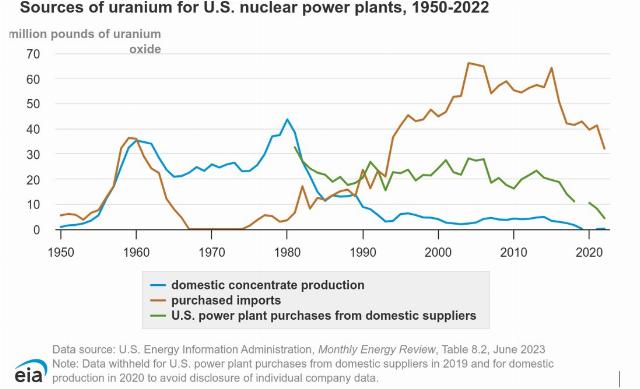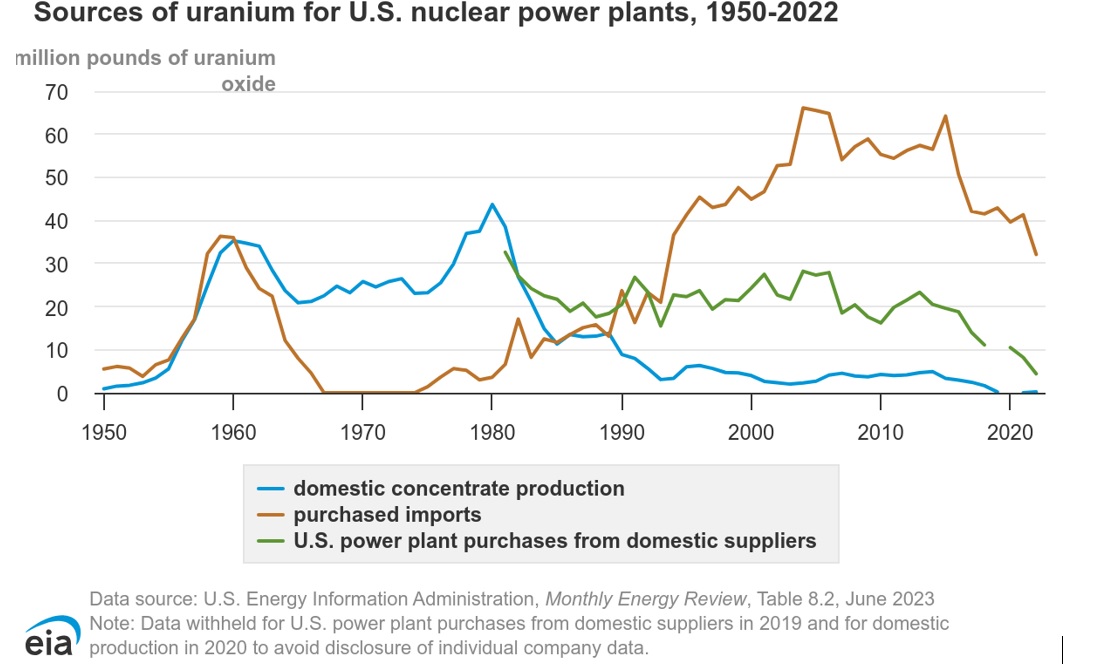

US Energy Information Administration
We all know that the only viable future solution for our growing energy needs is nuclear.We all know that the only viable future solution for our growing energy needs (even without EVs and banning of other products that use “fossil” fuels) is nuclear. Solar and wind aren’t going to cut it. Logical people have not only known that for decades, it is proven to us over and over again with solar fields being destroyed by hailstorms and other natural events, and wind turbine blades crashing to the ground or into the ocean. Both technologies also create a lot of waste even if they do survive a useful life. Turbine blades are too big to dispose of and/or recycle, and solar panels only last a few decades at best and contain toxic materials that would leach into ground if disposed of in landfills.
The few remaining nuclear plants still operating in the U.S. currently provide about 19% of the energy we use. It’s clean and reliable. However, nuclear hasn’t been without its drawbacks. Yes, the disasters of Chernobyl, Three Mile Island, and Fukushima get all the headlines and stoke fear in the hearts of many, but that was old technology. By analogy, cars of past used carbureted engines fed by rubber hoses that were prone to leaks and fires. Cars these days use stainless steel fuel lines and fuel injection and aren’t anywhere near as prone to fires. “Cars,” that is, except for EVs. EV fires? Well… that’s for another article.
The biggest reason utility companies aren’t scrambling to build new nuclear plants now are complex, burdensome regulations that limit domestic production of uranium and limit options for disposal of spent nuclear fuel.
<img alt captext="US Energy Information Administration” src=”https://conservativenewsbriefing.com/wp-content/uploads/2024/08/more-hope-for-nuclear.jpg” width=”450″>
Domestic uranium production peaked in the 70s and has since been almost completely erased by imported uranium. Why? Same reason many rare-earth materials are outsourced to other countries… the environment.
“In 1952, Mountain Pass opened. First explored as a uranium deposit, it soon supplied rare earths for the electronic needs of the Cold War economy. Until the 1990s, it stood alone as the only major source of rare earths worldwide.”
“By 2002, however, the mine was defunct. In the eyes of the U.S. government and major manufacturers, it no longer made sense to acquire rare earths from a U.S. source subject to stringent environmental regulations. Instead, the hard business of extracting useful minerals was exported to other countries, where environmental damage was safely out of sight.”
Disposal is another problem. According to the Epoch Times:
“By the terms of the Nuclear Waste Policy Act of 1982, the U.S. Department of Energy (DOE) is responsible for the safe disposal of nuclear waste. But thus far, the DOE has left that task to electric utilities while it awaits funding to build storage sites, such as the proposed repository at Yucca Mountain in Nevada.
“DOE is responsible for disposing of this high-level waste in a permanent geologic repository but has yet to build such a facility because policymakers have been at an impasse over what to do with this spent fuel since 2010,” the U.S. Government Accountability Office reports.
Meanwhile, the volume of spent nuclear fuel that utilities have kept in temporary storage continues to pile up by an additional 2,000 metric tons each year, prompting utilities to successfully sue the government for breach of contract.”
However, it seems the tide might just be turning a bit. Technology for recycling of spent nuclear fuel has been around since the 1950s, and other countries have been doing it successfully (and profitably) for decades.
“Orano, one of the world’s largest commercial recycling companies, has reprocessed more than 40,000 metric tons of used nuclear fuel since 1976, much of which is placed back into reactors to generate electricity.”
In prior years there has been much back-and-forth in various administrations on regulations regarding spent nuclear fuel, which is why private utilities are gun-shy over making large investments since many have lost a lot of money over the years when policies have inevitably flipped. It appears, however, now that our backs are against the wall as energy-hog data centers proliferate, coal and natural gas plants are planning to close, and the pseudo-power generators of solar and wind prove their uselessness, bipartisan support might be on the horizon to advance nuclear power again, this time with support for recycling spent fuel.
“Through recycling, 96 percent of used nuclear fuel, comprising 95 percent uranium and 1 percent plutonium, can be repurposed into new nuclear fuel or used for other purposes. The remaining 4 percent is sealed in glass and placed in metal containers for about 300 years until it decays to the original low-level of radioactivity of the uranium first mined.”
“By comparison, current storage periods for non-recycled UNF range between 10,000s and 100,000s of years.”
“But Roberts says Orano is working to find uses for even some of this residual 4 percent, which contains “potentially useful materials such as krypton-85, strontium-90, americium-241, and rare-earth and lanthanide elements.”
Recycling fuel solves two problems at once, supply and disposal. Why we are not running full speed ahead on this already is likely because of the current administration in charge who would love to see this nation fail instead of thrive. If we are blessed with another Trump administration in 2025, watch for this to be fast-tracked.



